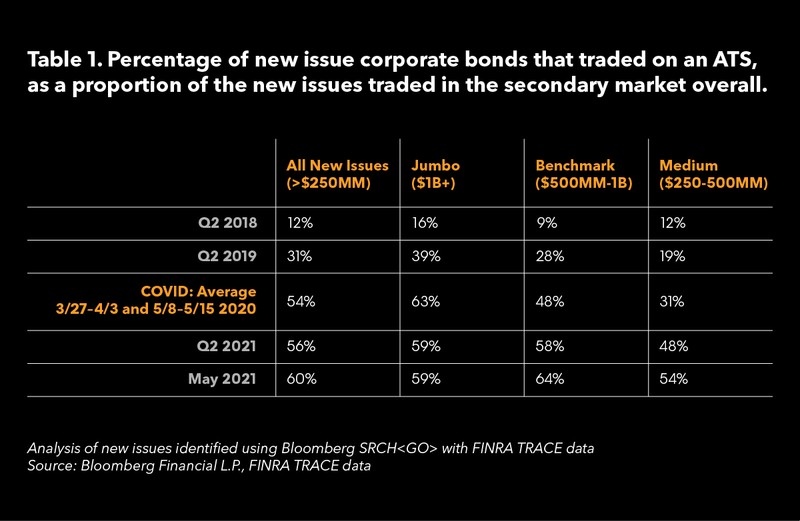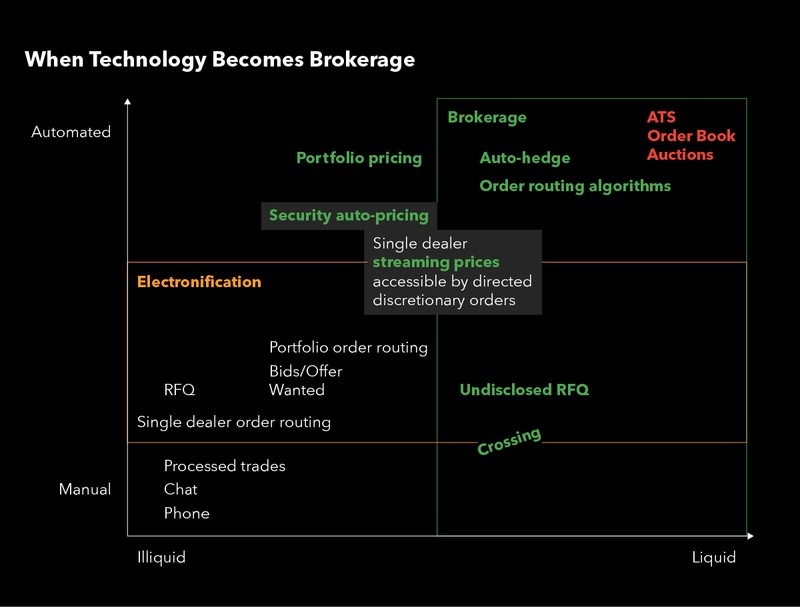This article was written by Derek Kleinbauer, Global Head – Fixed Income & Equity e-Trading and Gary Stone, Regulatory Analyst and Market Structure Strategist at Bloomberg.
The pandemic accelerated the adoption of fixed income electronified workflows and electronic trading – especially in new issue corporate bonds on the day that they are priced and “free to trade” in the secondary market. These trends were solidly in place prior to March 2020, and the data shows that the growth continued over the next 14 months – following a pattern of “hockey stick” growth (Table 1). Looking at the numbers, it’s clear that the electronic trading of new issues is now a standard practice of the corporate bond market.

FINRA publishes transaction data in real-time from its Trade Reporting and Compliance Engine (TRACE). TRACE identifies the transactions that are completed electronically on an ATS, however, these transactions represent only a subset of transactions that are completed electronically (Figure 1). For instance, the data does not identify transactions completed by leveraging electronified workflows (Figure 1, “Electronification” ~ yellow box).

Nevertheless, FINRA’s dataset is highly instructive, especially when analyzing and segmenting new issues by issue-size. With a focus on behavior changes and the evolution of the market structure, an issue size threshold of $250 million was set to identify the new issues most conducive to trade electronically. This threshold comes from three sources. In their August 2017 report “Access to Capital and Market Liquidity”, the Staff of the Division of Economic and Risk Analysis of the Securities and Exchange Commission, supported by several academic research studies identified $250 million issue size as a liquidity threshold. The Bloomberg Barclays Indices also applies a minimum amount outstanding security-level liquidity rule for the purposes of inclusion. Until April 2017, prior to raising the threshold to $300 million, the Bloomberg Barclays Indices used a $250 million outstanding size as the inclusion liquidity threshold for credit bonds in the US Aggregate.
Not all bonds trade in the secondary market after being “free to trade” on the day that they are priced. There are a variety of reasons for that. To measure the growth of electronic trading, the behavior being measured is if a new issue trades in the secondary market, are market participants also (comfortable) trading it electronically on an ATS? The data from FINRA’s TRACE provides us with the number of new issue corporate bonds traded on an ATS as a percentage of new issues that traded in the secondary market.
According to the analysis of FINRA’s TRACE data (Table 1), in Q2 2018 only 12 percent of new issue corporate bonds with an issue size of $250 million or more that traded in the secondary market after being “free to trade” also traded electronically on an ATS. By Q2 2019, the percentage topped 30%. And, Q2 2021, over 50% of the new issues with issue sizes $250 million or more that traded in the secondary market after being “free to trade” also traded electronically on an ATS. In May 2021, that percentage reached to 60%.
Evolution of market structure
The data only illustrates the growth in electronic trading – at the top of the market structure pyramid. There are three distinct stages of market structure and associated trading protocols at each stage of a market’s structural evolution: manual, workflow electronification and electronic trading. Trading protocols can be segmented along the continuum of illiquid and liquid securities into manual, workflow electronification, brokerage and electronic trading/ATS activities (Figures 1 and 2). These stages and protocols have repeated across the maturation of the equities, options, futures, and foreign exchange market structures (Figure 2). Now, it’s the turn of the fixed income markets.
Figure 2. The Evolution of Electronification to Electronic Trading Protocols

While there is a clear difference between electronified workflows and electronic trading, the two are often conflated. The threshold of electronic trading is where methods of electronification – directed discretionary trade messaging and order routing – cross over into rules-based, non-discretionary algorithmic routing, pricing and strategies and the formation of market places. The electronic trading threshold is where traders surrender discretion to automation and trading protocols go from discretionary to brokerage and ultimately (central limit) order books, call auctions and crossing on ATSs.
FINRA’s December 23, 2020 data proposal (“Enhancements to TRACE Reporting for U.S. Treasury Securities,” Member notice 20-43) should shed light on this evolution. FINRA is considering adding additional tags to reported transactions to identify that the associated orders leveraged certain electronified workflows. Although FINRA is initially contemplating if the proposal would apply only to the TRACE reporting of transactions in U.S. Treasury securities, they are requesting comment on whether the proposal also should be considered for other types of TRACE-eligible securities, such as corporate bonds. Although the data could be collected through end-of-day transaction reporting rather than in real-time TRACE reports, this initiative could help drive data-focused conversation about market structure.
The shift to electronified workflows and electronic trading shown in the data are not going away as the market returns to the office. In a February 19, 2021 interview in the Financial Times, “COVID-19 forces electronic shift in bond markets”, Kevin McPartland, head of market structure and technology research at Coalition Greenwich noted: “While people will find their way back to offices over time, the new tools and technology they have adopted are here to stay.” The data shows that electronic trading in all fixed income was on the rise prior to the pandemic — COVID-19 accelerated the trend. The adoption of electronic trading new issue corporate bonds were no exception.